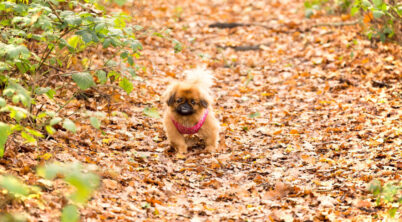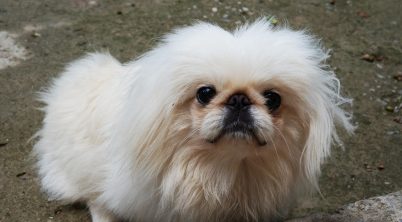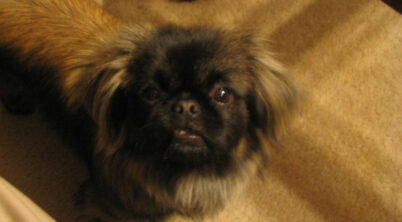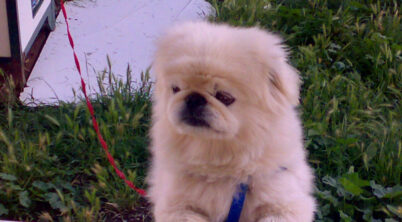The Pekingese, a toy breed that hails from the imperial courts of China, carries a complex temperament shaped by its regal heritage. Known for their distinctive lion-like mane and compact stature, Pekingese were once the cherished companions of Chinese royalty. This breed’s historical status as a favored pet of the noble class has influenced its behavior and interactions with other dogs. Their demeanor often reflects a blend of dignity and independence, traits that were admired and nurtured within the confines of the palace. However, despite their small size, they may exhibit a spirited and confident character, which can affect their social dynamics with other canines.
Interaction with other dogs can be variable for a Pekingese. The breed may sometimes display an air of aloofness, a sentiment that perhaps echoes their ancestral role of sitting alongside Chinese emperors and nobles. Their self-assured nature can lead to assertiveness when encountering other pets, which necessitates early socialization to foster amicable relationships. Although the Pekingese can adapt to living with other dogs, it is imperative that they are introduced patiently and respectfully to their fellow companions to mitigate potential territorial behaviors.
Susceptible to spoiling due to their endearing appearance and storied past, a Pekingese may develop what some interpret as a ‘royal’ attitude, not unlike the temperament that would have been cultivated in their early existence within the Chinese court. Their introduction to the Western world, notably accentuated by an association with Queen Victoria who received one as a gift, has only augmented their international appeal. To integrate well with other dogs, the Pekingese’s training should be consistent and gentle, emphasizing positive reinforcement to leverage its innate intelligence and eager-to-please nature under the right guidance.
Table of Contents
Pekingese Temperament With Other Dogs
Socialization
Pekingese dogs can exhibit a wide range of social behaviors with other dogs, largely influenced by their early socialization. It is essential for a Pekingese to be socialized with other dogs from a young age to encourage positive interactions. Without proper socialization, a Pekingese may become reserved or display aggression towards other dogs.
Dominant Behavior
They are often confident and may display dominant behavior towards other dogs, regardless of size. The Pekingese’s boldness means that they may not back down from confrontations easily, and they might challenge larger dogs.
Companionship
If introduced properly and from an early age, the Pekingese can coexist well with other dogs. They are generally capable of forming strong bonds and participating in group play, though their interaction style may still reflect their dignified nature.
Potential Aggression
Owners should be aware that this breed can sometimes be stubborn and might assert their will, which can lead to tension with other canines. It is not uncommon for a Pekingese to exhibit some degree of possessiveness over their belongings or their human companions, which may cause friction with other household dogs.
Monitoring Interactions
In multi-pet households, interactions should be monitored to ensure that play remains friendly. The Pekingese’s temperament can be well-managed through consistent training and a clear understanding of hierarchical structure within the home.
Key Points:
- Early socialization with other dogs is crucial.
- Can display a confident and, at times, dominant demeanor.
- Capable of forming strong inter-canine relationships.
- Possessiveness over resources may lead to disputes.
- Consistent training is important to manage temperament.
Owners should consider these behavioral traits to ensure harmonious relationships with other dogs in the household or during outside encounters.
Pekingese Temperament
The Pekingese is a breed with a distinct set of personality traits, reflective of its regal history. They are known for being affectionate and loyal, yet can display a strong-willed and independent streak.
Personality Traits
The Pekingese possesses a dignified and confident character, often appearing to be aware of its ancestral ties to Chinese royalty. This breed can be exceedingly loyal to their family, often forming strong, affectionate bonds with their owners. Despite their small size, they exhibit a courageous spirit, which is a remnant of their history as companions to Chinese emperors, where they were likened to lions. However, they can also be quite stubborn, which may require patience and consistent training.
Interactions with Other Dogs
When it comes to temperament with other dogs, the Pekingese may show signs of being independent and sometimes assertive. Socialization at an early age is vital for a Pekingese to become more accepting and gentle with other dogs. Without proper socialization, they may attempt to dominate other dogs, regardless of size, which highlights their stubborn and confident nature. It is important to note that while they can learn to coexist with other pets, they do best with dogs of similar size and temperament.
Health and Grooming
Pekingese dogs have distinct grooming needs due to their long coats and a set of common health concerns largely inherent to their brachycephalic nature.
Grooming Needs
The Pekingese breed requires regular grooming to maintain its coat’s health and appearance. Owners should establish a routine that includes frequent brushing—at least a few times a week—to prevent matting and reduce shedding. Giving these dogs a bath every few weeks can help keep their skin and coat clean, though care should be taken to dry them properly to avoid skin infections. Additionally, attention should be given to trimming the hair around their eyes to prevent irritation and around their bottom for hygiene purposes.
Health Concerns
Pekingese are a brachycephalic breed, meaning they have short noses and flat faces. This anatomical feature can lead to breathing problems, so it’s important for owners to monitor their pets, especially in hot or humid weather, and restrict excessive exercise. Obesity is another concern for the Pekingese; excess weight can exacerbate breathing difficulties and put additional strain on their compact frames. Owners should be consistent with diet and exercise routines to manage this risk. Regular veterinary check-ups are essential to identify and manage common health problems associated with the breed, including but not limited to eye issues and skin conditions.
Training and Socialization
Training and socialization are vital for Pekingese dogs, as they can exhibit stubbornness that stems from their intelligence. Implementing consistent training techniques early on and socializing them with animals and people are key for a well-behaved pet.https://www.youtube.com/embed/ZnK0j6qLMMw
Training Techniques
Positive Reinforcement: To counterbalance the Pekingese’s inherent stubbornness, trainers should rely on positive reinforcement methods. These include offering treats, praise, and play to encourage good behavior. Consistency is crucial so that the Pekingese can associate specific actions with rewards.
- Exercise: Regular exercise is an element of training, as it helps maintain the Pekingese’s physical health, and provides mental stimulation.
- Obedience Training: Obedience classes can not only instill basic commands but also teach impulse control to prevent unwanted behaviors such as biting and excessive barking.
Socializing with Animals and People
Early Socialization: Exposing the Pekingese to various environments, animals, and people at a young age is essential. This exposure helps them to become well-adjusted and less reactive toward unfamiliar situations or beings.
- Controlling Aggression: Controlled introductions to other animals should be conducted to manage and reduce displays of aggression or dominance.
- Habituation: Acclimating the Pekingese to different sounds, smells, and sights helps in developing their social comfort, effectively deterring fearful or aggressive responses to new stimuli.
Living with a Pekingese
The compact Pekingese breed is revered for its loyalty and affection towards their family. Recognized for their regal demeanor, Pekingese can be both noble companions and charming family pets.
Family Integration
Pekingese form strong bonds with their human companions, often showing a high level of loyalty to all family members. They are particularly well-suited for families with older children who understand how to interact with small dogs. These dogs may exhibit a degree of reservation around strangers, but integrate well into family life, often getting along with family dogs and other pets. For households with younger children, supervision is recommended to ensure gentle interaction.
Exercise Requirements
Despite their small size, Pekingese possess a moderate level of energy and require regular exercise to maintain their health and happiness. A Pekingese does not need extensive exercise routines; short daily walks combined with playtime will typically suffice. Their activity requirements can generally be met with indoor games and a secure space to explore outdoors. It’s key for owners to balance their Pekingese’s activity level to prevent weight gain, ensuring a happy and healthy canine companion.
Pekingese and Other Pets
The Pekingese, a toy breed, often forms a harmonious relationship with other pets when they are properly socialized. Their interactions with small dogs and other animals can be positive, provided they have been introduced and trained correctly.
Introducing to Other Pets
When introducing a Pekingese to new pets, a gradual and patient approach is essential. They are known for their independence and bold personalities, which can challenge their interactions with unfamiliar animals. Here are key strategies:
- First Encounters: Supervise initial meetings in a neutral area.
- Positive Association: Use treats and praise to create a positive experience.
- Incremental Exposure: Gradually increase shared time as they show comfort.
Managing Multiple Pets
Maintaining harmony in a household with a Pekingese and other pets requires consistent management. Owners must monitor interactions and provide separate spaces when required.
- Feeding Time: Ensure pets have individual feeding areas to prevent food aggression.
- Personal Spaces: Provide each pet with their area for retreat and relaxation.
- Empower with Training: Teach commands to promote peaceful coexistence, like ‘sit’ and ‘stay’.
With these strategies, a Pekingese can be a congenial companion to other household pets.
Responsible Ownership
Responsible ownership of a Pekingese involves understanding their specific needs and habits, especially when it comes to interactions with other dogs, and committing to their care throughout their life.
Adoption and Rescue
When considering the addition of a Pekingese to the family, prospective owners should first look into rescue groups. These organizations often have adult dogs that have already developed distinct personalities, making it easier to identify a Pekingese whose temperament would be compatible with other dogs in the household. Furthermore, they may also provide insights into the dog’s diet and nutrition, which are crucial for the Pekingese’s long-term health.
- Checklist for Adoption and Rescue:
- Inquire about the Pekingese’s history with other dogs.
- Confirm dietary preferences and nutrition plans.
- Discuss the health and vaccination records.
Long-Term Commitment
A Pekingese can typically live between 12 to 15 years, signifying a considerable long-term commitment for the owner. Understanding their role as a watchdog—not to be confused with larger, more traditional watchdogs—is important. This breed often has a strong territorial instinct and, while they can be polite, may not always interact well with other dogs or pets. Continuous socialization and proper training are vital for a harmonious living environment.
- Long-Term Ownership Considerations:
- Life Expectancy: Approximately 12-15 years.
- Temperament: May serve as alert watchdogs, requiring socialization for good behavior with other dogs.
- Healthcare: Maintaining a high standard of healthcare to facilitate a full and healthy life.








